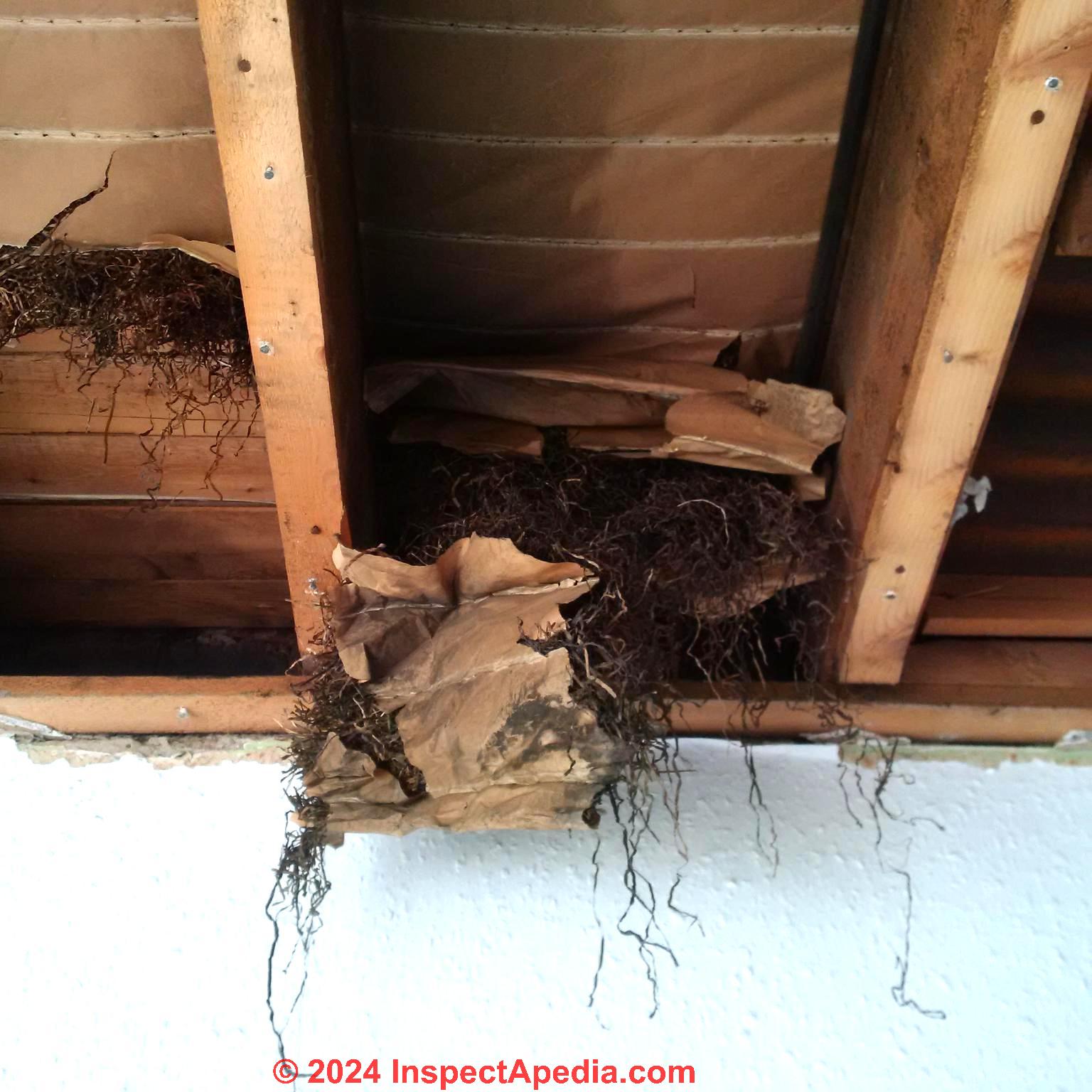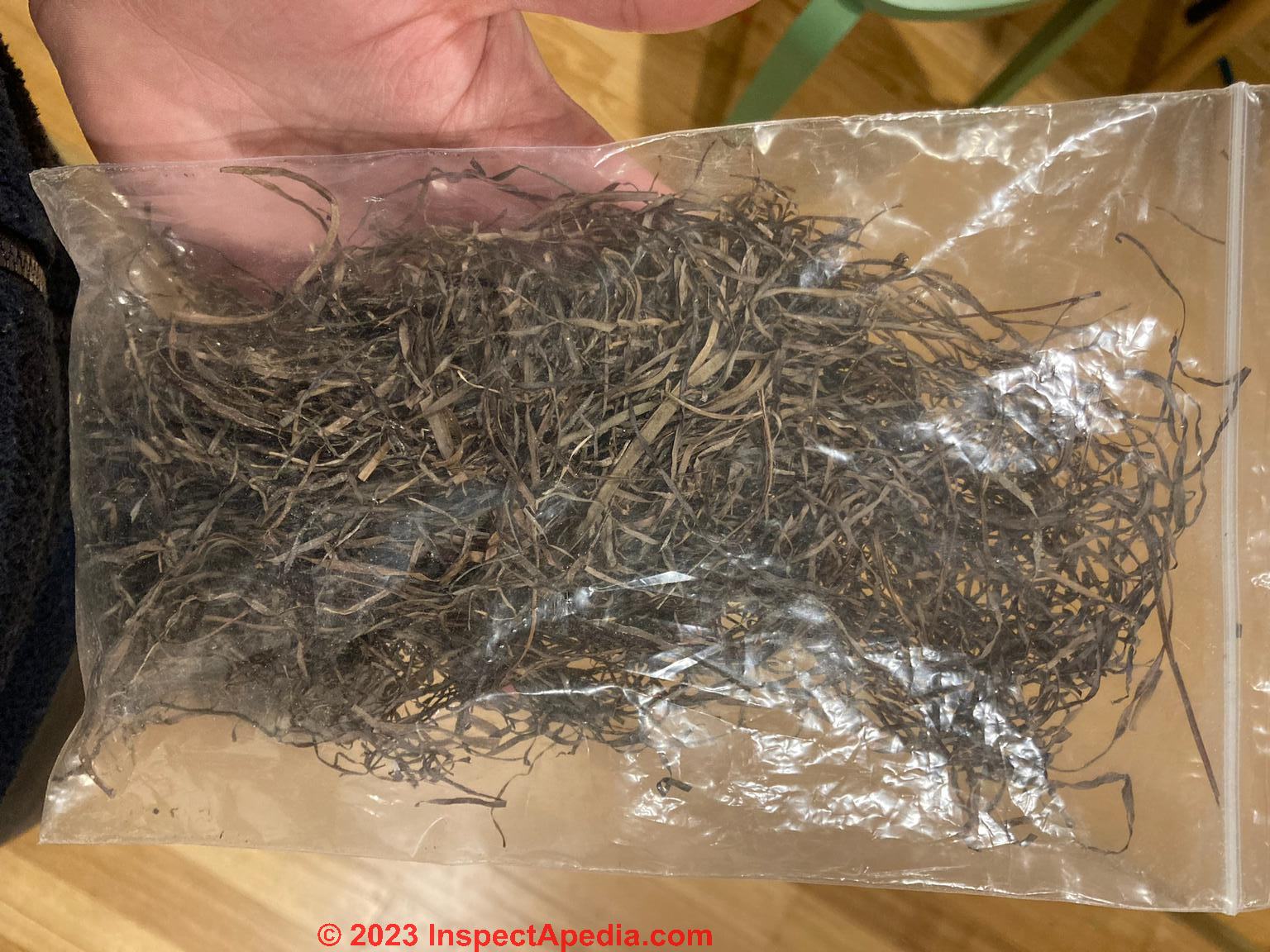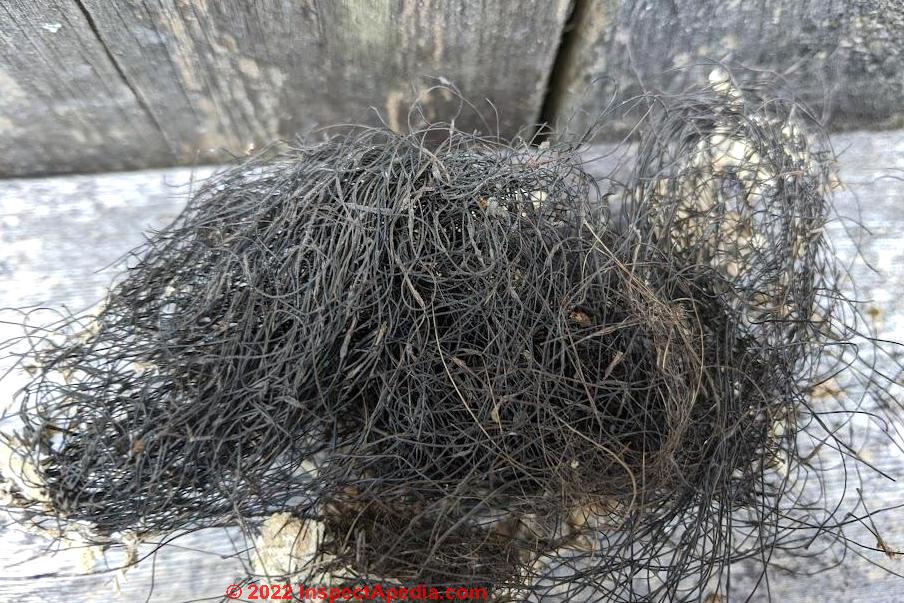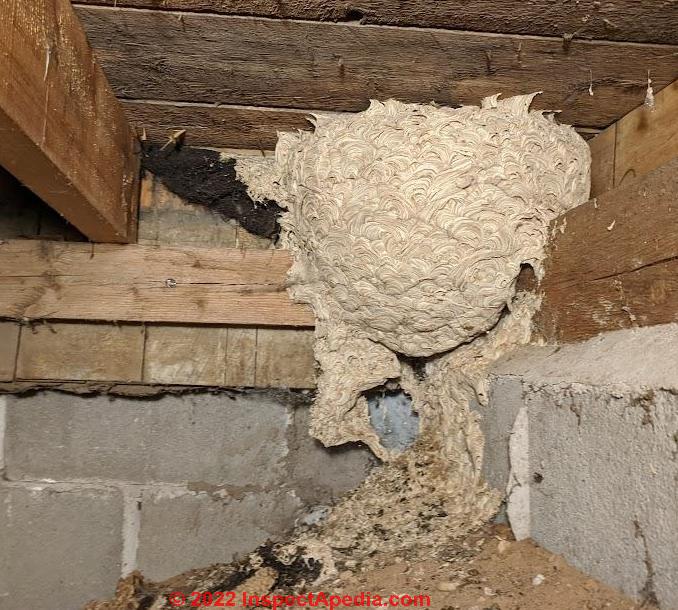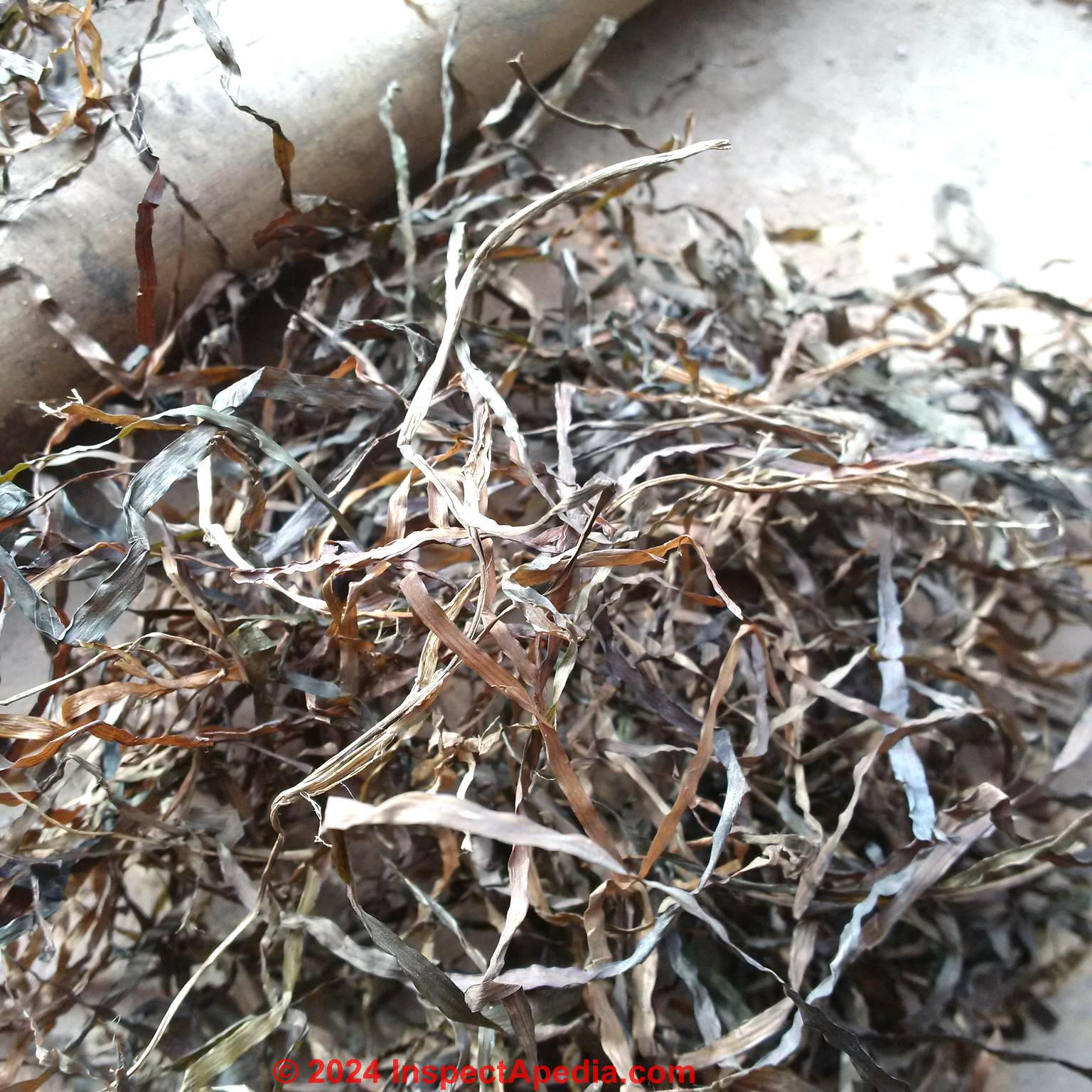 Seaweed and Eelgrass Insulation
Seaweed and Eelgrass Insulation
Types of insulation using seaweed or eelgrass
- POST a QUESTION or COMMENT about seaweed insulation
Seaweed and Eelgrass Insulation: Types of insulation using seaweed or eelgrass.
This article describes types of insulation using seaweed or eelgrass.
We illustrate and include photographs of seaweed and eelgrass insulation as well as discuss some of the history and use of seaweed and eelgrass production in Canada and the United States.
InspectAPedia tolerates no conflicts of interest. We have no relationship with advertisers, products, or services discussed at this website.
- Daniel Friedman, Publisher/Editor/Author - See WHO ARE WE?
Types of Insulation Materials Using Seaweed or Eelgrass
Used for a number of purposes throughout history, including insulation, roof thatching, and food, eel-grass and seaweed insulation can still be found in some homes.
Article Contents:
Eel-grass Insulation
Widely harvested and used in the middle ages in Europe as insulation and as thatch for roofing in Denmark and Scotland, then in North America by native americans as food or for smoking meat, and as insulation in Nova Scotia as well as in the Northeastern U.S., eelgrass has an ancient history.
Our most complete description is in Cabot's Insulating Quilt cited and is given as a PDF download below. Cabot described "Cabot's Quilt" as both a heat insulator and as sound deadening insulation that he called "Sound Deafening Quilt."
Cabot cites the Old Pierce House in Dorchester Massachusetts that was constructed in 1635. When the home's walls were opened for repairs in 1893 workers found that the home had been insulated with eel-grass that Cabot reports "... was in a perfect state of preservation after more than two and a half centuries."
Eelgrass was found in other historic homes, again excerpting from Cabot, to include the Babcock Housein Milton, MA (1723) and others (un-named) in Connecticut and Nova Scotia.
Cabot's eel-grass sources included both New England in the U.S. and Nova Scota from whose farmers he began buying that product in 1907. A crop disease essentially destroyed the eel-grass industry between 1930 and 1931, and the last U.S. eelgrass insulation produced by Cabot ended eleven years later in 1943. In Canada eelgrass production continued by Guildford's under the brand name "Seafelt Insulation" between 1943 and ca. 1965.
In appearance eelgrass insulation looks like a coarse tan-brown fibrous material - or like straw or grass. [Photos & photo-permissions sought, use our page top or bottom CONTACT link - Ed.]
- Bozsaky, Dávid. "The historical development of thermal insulation materials." Periodica Polytechnica Architecture 41, no. 2 (2010): 49-56.
- Cabot, Samuel, HEAT INSULATION, CABOTS INSULATING QUILT [PDF] (1923) Samuel Cabot, Inc.., New York, Chicago, Samuel Cabot, Sole Manufacturer, 147-A Milk St., Boston MA (1906) - retrieved 2023/04/29 original source archive.org/details/HeatInsulationCabotsInsulatingQuilt
- Scott, D.L., HOUSE DEMOLITION REVEALS EARLY USE OF INSULATED SHEATHING [PDF] Canadian National Archives, - retrieved 2023/04/29, original source: nrc-publications.canada.ca/eng/view/ft/?id=616c13a1-fa3c-4628-8160-dfe87d567ecd
Excerpts:
Cabot's Quilt was composed of a thin layer of eel-grass (seaweed) between two layers of kraft paper that were stitched together to farm 915 mm (1 yd.) wide rolls
Patented in 1915 and 1916, the materfal was applied horizontally using l? roofing caps" which are large washers stamped out of reclaimed sheet metal. The sheathing boards and studs backing up the Cabot's quilt were found to be dry and sound. Despite some water staining on bath the sheathing and Cabot's Quilt the system appears to have been able to cope with the moisture cycles imposed on it. - UK National Archives, "Thermal and insulation tests on `Cabots Quilt' eel-grass matting", 1945 July - 1947 - May, DSIR 4/1117 source: discovery.nationalarchives.gov.uk/details/r/C2324947
- Wyllie-Echeverria, Sandy, and Paul Alan Cox. "The seagrass (Zostera marina [Zosteraceae]) industry of Nova Scotia (1907-1960)." Economic Botany (1999): 419-426.
Seaweed Insulation
In pellet, loose, or shredded form encased in insulation batts, seaweed has served as insulation for generations. Below are examples with images depicting these types.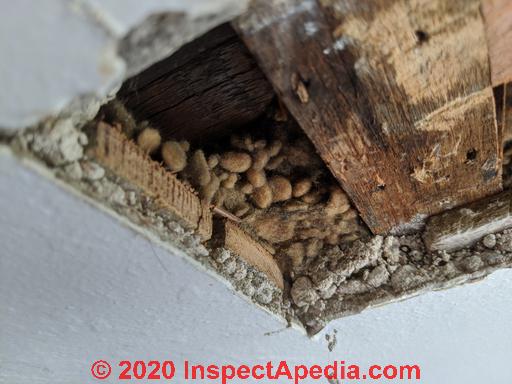 On 2020-06-13
by Mark - what are these brown pellets of insulation in the plaster ceiling?
On 2020-06-13
by Mark - what are these brown pellets of insulation in the plaster ceiling?
We have an older home built around 1920.
Found some odd looking insulation behind the lathe of one of our plaster ceilings.
Brown/ tan fibrous pellets.
Would mineral wool ever look like this?
On 2020-06-14 - by (mod) - pelletized fibrous insulation in buildings
Mark
Thanks for the very interesting question and photo of pelletized fibrous insulation. Building insulation in pellet form using fibrous materials has been used for decades, usually as a blow-in or pour-in insulating material.
Pellet forms of fiber type insulation have been made of cellulose (including seaweed as we'll show below), fiberglass, and also mineral wool or rock wool. (Hall 2011)
Your insulation looks to me like fiberglass but I agree it could be mineral wool or rock wool. Perhaps you can post a closer, enlarged and sharp image.If you want to mail me a sample for examination in our lab (no fee) I can look at it under the microscope to identify the fiber (possibly) later this fall - depending on COVID quarantine status.
Hall, Dennis J., and Nina M. Giglio, Graphic Standards Field Guide to Residential Construction, John Wiley & Sons, Apr 6, 2011 which is part of a series by Wiley (Volume 18 of Graphic Standards Field Guide series) ISBN 0470906286, 9780470906286
Below: Seaweed pellet insulation (this is not your material), from
- MaterialDistrict, Naarden, The Netherlands Tel: +31 (0)20 71 30 650 Email: info@materialdistrict.com
Please also tell us the age of the building and the country and city of its location.
On 2024-02-19 by Luke
 On opening the ceiling of my 1934 terrace, I found something that appears identical in all but name to Cabot's Quilt. It's named "Building Blanket" by the "Riverbank Mfg Co Ltd of New Glasgow Nova Scotia".
On opening the ceiling of my 1934 terrace, I found something that appears identical in all but name to Cabot's Quilt. It's named "Building Blanket" by the "Riverbank Mfg Co Ltd of New Glasgow Nova Scotia".
From what I can tell, Nova Scotia was a primary source for Cabot's operation and I can only assume that it's an almost identical product - perhaps even manufactured in the same facilities?
However, I'm in Edinburgh, Scotland.
- It's in one yard bag sections of strong building paper with stitching every 50mm or so
- It's sandwiched tightly between the floorboards and the joists
- It's dried grass-like leaves of various colours from dark grey-brown to dark emerald green
- It's in perfect condition except where electricians and plumbers have had their way
- It will burn in contact with a flame, but doesn't seem to self-sustain combustion well once the lighter flame is extinguished
- It does appear to offer some deadening of foot traffic overhead
(above and page top photo: seagrass extracted from "Builders Blanket" insulation batt)
On 2024-02-19 by InspectApedia Publisher
@Luke,
...
Thank you so much for that information it's really interesting. It would be really great if you could post some photos, one per comment, of the insulation itself and of the writing on the insulation facing
We did a little historical research for evidence that insulation produced in Nova Scotia was in fact shipped back to Scotland or elsewhere in the UK.
Riverbank Manufacrturing Co., Ltd. "Building Blanket" was listed in "Hardware and Tools Industry in Canada" published in 1932 -
- source: publications.gc.ca/collections/collection_2016/statcan/41-208/CS41-208-1932-eng.pdf
The company had an interesting history. Here's an excerpt from Pictou County's History
Eastern Steel Company after a disastrous fire declined. John Underwood reorganized it as the Riverbank Manufacturing Company Limited and continued to make farm implements, particularly harrow teeth.
Wrought iron ornaments and lamp stands were made. The firm had a promising future in 1928 from a new line, insulation made from seaweed. The latter's insulating properties had long been known and utilized to " bank" seashore houses in winter months.
The Riverbank Company assembled the seawood in blanket form, and builders were placing orders for it when the supply of seaweed failed. The weed that had grown for countless years along the Atlantic Coast, in the late 1920's and early '30's fell victim to a parasitic disease which killed it off.
The Riverbank Manufacturing Company Limited died with it. - source: www.novastory.ca/digital/api/collection/picbooks/id/5467/download
It's remarkable that Riverbank's seaweed-based building insulation was shipped to Edinburgh.
We look forward to seeing some photos if you're up for it.The fire that burnt down the earlier manufacturing plant occurred back in 1918. - source: Sandberg, L. Anders "THE DEINDUSTRIALIZATION OF PICTOU COONTY, Capital, Labour and the Process of Regional Decline, 1881-1921" - Thesis, Dept. of Geography, McGill University, Montreal, June 1985.
On 2024-02-20 by Luke
@InspectApedia Publisher, amazing info. Thanks. I've got some photos that might be helpful
Original "Building Blanket" manufacturers branding on one yard bags sandwiched between joists and floorboards in 1934 Terrace in Edinburgh, Scotland
reading "Riverbank mfg Co Ltd New Glasgow NS Canada"

Split open "Builders Blanket" showing filling
On 2024-02-20 by InspectApedia Publisher
@Luke,
These are wonderful images, thank you.
We'll preserve this discussion at our SEAWEED INSULATION section - inspectapedia.com/insulation/Insulation-Identification-Guide.php#Seaweed
and with this additional detail we'll make that into its own page.
I looked for a description of Riverbank Mfg. Co.'s Nova Scotia seaweed insulation being exported and didn't yet find that. But consider that there were trade ships sailing in both directions between Nova Socita and Scotland it's not a shock to think that the company also exported to Scotland.
McKay, Ian. "Tartanism Triumphant: The Construction of Scottishness in Nova Scotia, 1933-1954." Acadiensis 21, no. 2 (1992): 5-47.
may be of interest
www.erudit.org/en/journals/acadiensis/1992-v21-n2-acadiensis_21_2/acad21_2art01.pdf
and
Wyllie-Echeverria, Sandy, and Paul Alan Cox. "The seagrass (Zostera marina [Zosteraceae]) industry of Nova Scotia (1907-1960)." Economic Botany (1999): 419-426.
https://www.jstor.org/stable/4256225Abstract
Wild gathering of the leaves of the submerged marine monocotyledon Zostera marina L. once formed the basis of a vigorous insulation industry in North America.Since European colonization, fishing communities used detached leaves, deposited on the beach by tide and wind, as green manure and domestic insulation, but beginning in the late 1800s, these leaves were utilized in a commercial insulating product. Two companies manufactured seagrass "quilts" that were installed in many buildings of the period including some of the first skyscrapers.
We here describe the importance of seagrass gathering for the coastal community of Yarmouth County, Nova Scotia, Canada. Interviews with older residents and analysis of county and company archives facilitate the reconstruction of what was once a seasonally important activity. Our findings have direct application to global seagrass protection initiatives.
///
L'assemblage sauvage des feuilles submergés du monocotyledon marine, Zostera marina formait a un moment les bases d'une industrie d'isolation en Amérique du Nord.Depuis la colonisation Européenne, des communautés de pêcheurs utilisaient des feuilles détachées, déposées sur la plage par la marée et le vent comme engrais vert et isolation domestique; mais commençant à la fin des années 1800, ces feuilles séparées furent utilisées dans un produit commercial insultant.
Deux compagnies manufacturaient des "édredons" de pailleule qui furent installées dans plusieurs bâtiments de l'époque y compris dans certains des grattes-ciel.
Nous décrirons ici l'importance de l'assemblage de la pailleule pour la communauté côtière de Yarmouth County, Nova Scotia, Canada. Des entretiens avec des résidents d'un certain âge ainsi qu'une analyse du département et des archives de compagnies, facilitent la reconstruction de ce qui était à une époque, une activité saisonnière importante. Nos découvertes ont une application directes sur les initiatives de la protection globale de la pailleule.
...
Reader Comments, Questions & Answers About The Article Above
Below you will find questions and answers previously posted on this page at its page bottom reader comment box.
Reader Q&A - also see RECOMMENDED ARTICLES & FAQs
On 2023-06-18 by Jeff
Are you able to tell us what this loose ceiling insulation is.
It looks like shredded wood.
The house was built in 1950's in Melbourne, Australia
On 2023-06-18 by InspectApedia Publisher (mod) - seaweed-like insulation in 1950's in Melbourne, Australia home
@Jeff,
See SEAWEED INSULATION https://inspectapedia.com/insulation/Insulation-Identification-Guide.php#Seaweed
or a similar plant based insulating fibre.
and also tell me the country and city of location of the building and the building age.
On 2022-09-27 by Brian
Hi, I found this material stuffed up against the siding in my crawlspace. It's very coarse like horse hair or seaweed.
Here’s another photo for context. It’s the black material behind the hornet’s nest.
Just want to make sure it isn’t asbestos before I remove the nest.
This home is from the 1950’s, in Nova Scotia Canada, but the crawlspace was added later as an addition.
On 2022-09-27 by InspectApedia (Editor) - 1950s Nova Scotia seaweed insulation
@Brian,
Yes that looks like a plant fiber based insulation.
If you are on the coast or perhaps up on Cape Breton, it'd be no surprise if someone used dried seaweed as insulating material.
Also see our notes at
SEAWEED INSULATION
Watch out: removing a hornets' nest in a tight basement or crawl space can get you into serious trouble if the hornets are live. They get pretty mad when you start poking into the nest.
Keep us posted.
On 2022-09-28 by Brian
@InspectApedia (Editor), Thank you, this is very helpful. I am close to the ocean so it makes sense for it to be seaweed. I was able to remove the nest with no problems. It was not a live nest.
...
Continue reading at INSULATION IDENTIFICATION GUIDE or select a topic from the closely-related articles below, or see the complete ARTICLE INDEX.
Or see these
Recommended Articles
- FIBER & HAIR IDENTIFICATION
- INSULATION AIR & HEAT LEAKS
- INSULATION CHOICES & PROPERTIES
- INSULATION IDENTIFICATION GUIDE
- INSULATION INSPECTION & IMPROVEMENT
- INSULATION LOCATION - WHERE TO PUT IT
- INSULATION R-VALUES & PROPERTIES
Suggested citation for this web page
SEAWEED & EELGRASS INSULATION at InspectApedia.com - online encyclopedia of building & environmental inspection, testing, diagnosis, repair, & problem prevention advice.
Or see this
INDEX to RELATED ARTICLES: ARTICLE INDEX to BUILDING INSULATION
Or use the SEARCH BOX found below to Ask a Question or Search InspectApedia
Ask a Question or Search InspectApedia
Try the search box just below, or if you prefer, post a question or comment in the Comments box below and we will respond promptly.
Search the InspectApedia website
Note: appearance of your Comment below may be delayed: if your comment contains an image, photograph, web link, or text that looks to the software as if it might be a web link, your posting will appear after it has been approved by a moderator. Apologies for the delay.
Only one image can be added per comment but you can post as many comments, and therefore images, as you like.
You will not receive a notification when a response to your question has been posted.
Please bookmark this page to make it easy for you to check back for our response.
IF above you see "Comment Form is loading comments..." then COMMENT BOX - countable.ca / bawkbox.com IS NOT WORKING.
In any case you are welcome to send an email directly to us at InspectApedia.com at editor@inspectApedia.com
We'll reply to you directly. Please help us help you by noting, in your email, the URL of the InspectApedia page where you wanted to comment.
Citations & References
In addition to any citations in the article above, a full list is available on request.
- Carson, Dunlop & Associates Ltd., 120 Carlton Street Suite 407, Toronto ON M5A 4K2. Tel: (416) 964-9415 1-800-268-7070 Email: info@carsondunlop.com. Alan Carson is a past president of ASHI, the American Society of Home Inspectors.
Thanks to Alan Carson and Bob Dunlop, for permission for InspectAPedia to use text excerpts from The HOME REFERENCE BOOK - the Encyclopedia of Homes and to use illustrations from The ILLUSTRATED HOME .
Carson Dunlop Associates provides extensive home inspection education and report writing material. In gratitude we provide links to tsome Carson Dunlop Associates products and services.







